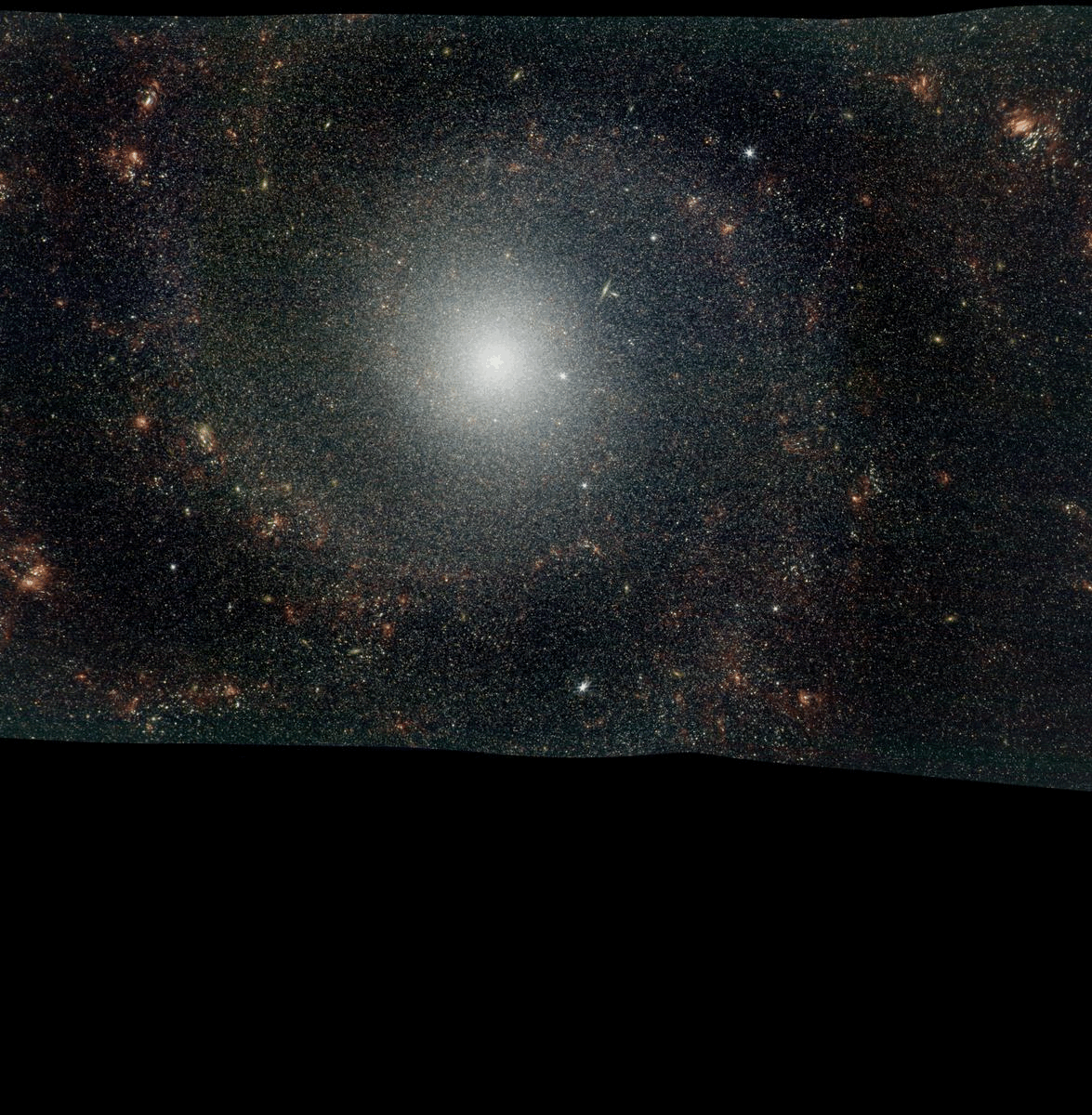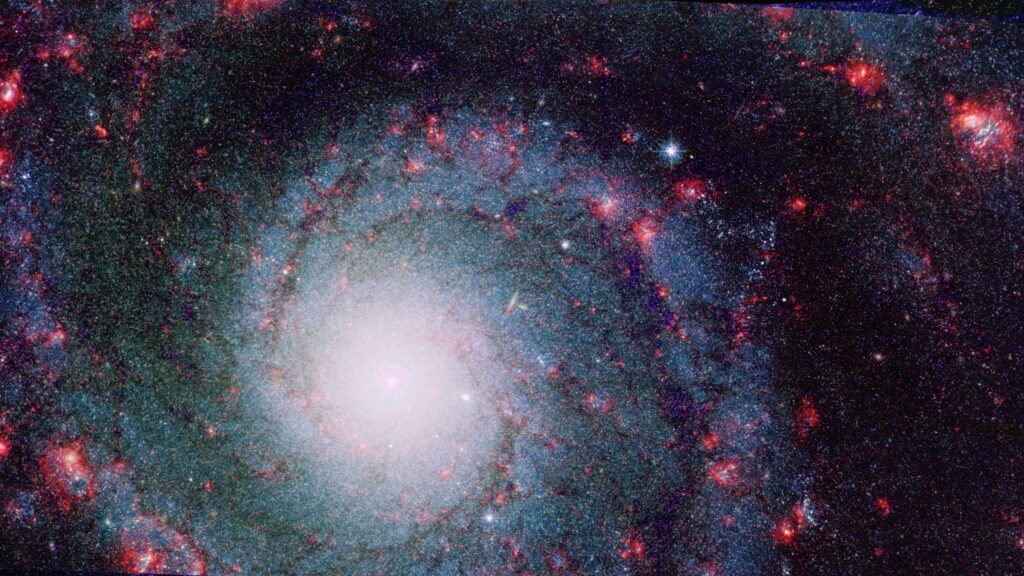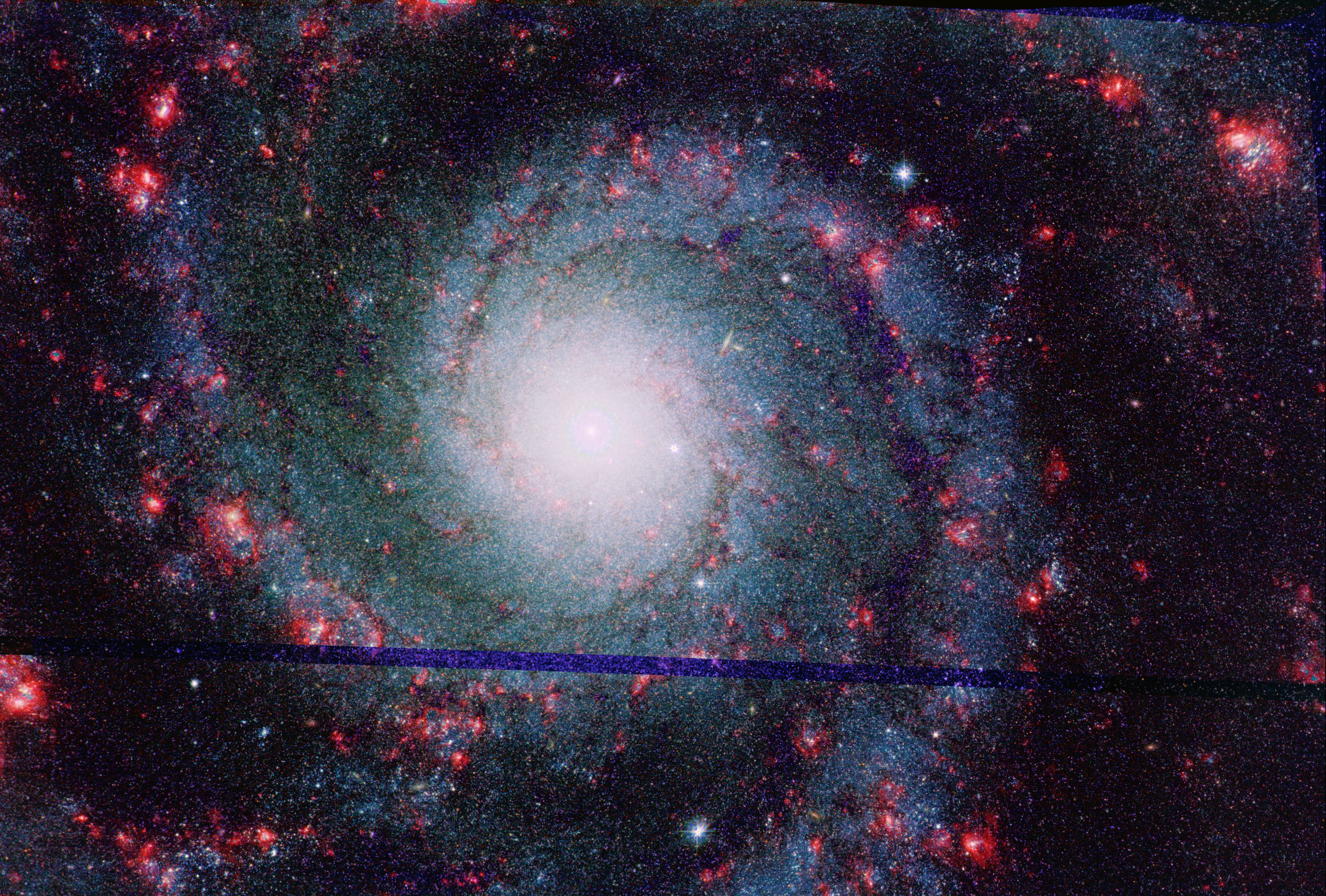Composite Image Produced from Two Flagship Orbiting Observatories
At 32 million light years, this image of the Grand Design spiral galaxy, M-74 appears in this composite rendition using JWST and Hubble data. The JWST component includes data in the 2, 3 and 3.6 micron range. The Hubble component includes 435 nm, 555 nm, 656 nm (H-alpha) and 814 nm (near-ir) image data. The blue bar bisecting the image represents a discontinuity in the archival HST data. (png image, 28 mb, 3960 x 2677). Image data: MAST, STSci, NASA/ESA/CSA. Processing by James Daly, Ph.D.
We present a composite image of the “Grand Design” spiral galaxy, Messier-74 (NGC-628) using JWST and Hubble data.
As we did with NGC-1365, we processed the image from data obtained directly from the data and image repository at the Space Telescope Science Institute (MAST). Similar projects for this target have used MIRI (Mid-Infrared) data from JWST and optical (ACS) data from Hubble to produce composite images. Descriptions of these renderings [of the galaxy] thus characterized it as a “Phantom Galaxy” for its “ghostly” appearance, produced from the two disparate regions of the spectrum. The “Phantom Galaxy” image was produced as part of a study of 19 nearby star-forming galaxies in the infrared by the international PHANGS collaboration. In both cases, the optical data from Hubble included Hydrogen-alpha (H-alpha), mapping all the star-forming regions.
Messier 74 (NGC-628) as a Grand Design Spiral Galaxy
NGC-628 (Messier-74) is a type Sc, Grand Design Spiral Galaxy 32 million light years distant in the constellation Pisces. It is 95,000 ly wide and is the principal member of a small physical group of galaxies known as the M-74 group.
Instead of using JWST’s mid-infrared MIRI data, we used NirCam data in the 2, 3 and 3.6 micron range. Unlike the MIRI composites, highlighting the confluence of the cool gas and dust with star forming regions, our image pierces the gas and dust, revealing the myriad stars embedded within.
It must be remembered that some resolution is lost with MIRI data compared to HST. Because resolution depends on wavelength and aperture, the HST images have a higher resolution than the MIRI images. Since NirCam begins at 600 nanometers wavelength (red light), NirCam images would have a resolution comparable to HST. The available JWST data unfortunately does not include any 600 nm NirCam data. We use only NirCam data to produce our composite, revealing different aspects of the Grand Design Spiral Galaxy, M-74.
The “Grand Design” designation describes such a galaxy as having prominent, well-defined spiral arms compared to multi-arm spirals with more subtle structural features. Our Milky Way galaxy is not a grand design spiral but is thought to be a “Barred Spiral” such as NGC-1365.
Galactic Structure
Ever since Edwin Hubble published his seminal work in 1929 with F. Zwicky, Walter Baade, Harlow Shapley, Vera C. Rubin and others later on, we’ve known of and observed the true nature of the “Spiral Nebulae” as separate galaxies external to the Milky Way. Prior to that, these objects were believed to be part of the Milky Way and were the subject of The Great Debate in 1920. The collaboration of so many in the intervening 100 years since Hubble has culminated in a mature understanding of galactic structure and evolution.
Why the Composite Image?
As it was during NASA’s Great Observatories Program, imaging across multiple wavebands of the electromagnetic spectrum allows for a more accurate understanding and representation of the target. In the case of NGC-628 / Messier-74, the integrated composite allows us to see the stars embedded in the gas-and-dust rich spiral arms that would normally be obscured.
The Thin Disc
It is well understood that spiral arms are prolific star-forming regions.
In the case of M-74, numerous H-II star-forming regions can be seen in both the HST and JWST images. The galaxy’s spiral arms and extremities (part of the “thin disc”) are replete with these characteristic bright-red/pink regions. These Hydrogen-alpha emission nebulae are observed at 656 nm, the longest wavelength in the Balmer hydrogen series. The red component of our HST image is itself a composite of H-alpha at 656 nm and near-infrared at 814 nm.
The arms are populated with young, luminous Population I stars and this is confirmed in our images. These stars are young, luminous blue O and B-class stars, formed in the gas-dust-rich environment of the thin disc (spiral arms). These high-mass, high-luminosity stars are resolved by both telescopes at 32 million light-years. Like grains of sand on a beach, they’re seen as tiny, fine points of light interlaced in the gas and dust of the spiral arms. The composite image reveals these stars that would be otherwise obscured by that gas and dust.
The Galactic Bulge
It is also well-understood, that older, population II stars populate the central core and galactic bulge. This characteristic of spiral galaxies is observed in our own Milky Way. The population density of stars from center to edge, with the broad changes in color and hue, confirms this aspect of galactic evolution and stricture. The central galactic bulge has a decidedly warmer hue while the thin disk and arms are decidedly bluer.
HST-JWST Composite Animation
To better visualize the integrated image and how it should be interpreted, the following animation provides the necessary detail. The animation begins with the JWST RGB image (details listed below), followed by the HST and finally, the composite.

Beginning with the JWST infrared image, followed by the HST optical image, this animation illustrates the integration process that transforms the two images into one composite image, an image that highlights the unique aspects of both. The high-redshift galaxies NE of the core (upper right quadrant) are clearly visible in this HST-JWST composite animation. The blue bar bisecting the image represents a discontinuity in the archival HST data.
A pair of high-redshift galaxies appear NE (upper-right) of the core and are clearly visible in the composite animation. A third high-redshift galaxy appears to the right (east) of the galaxy’s core and can be identified fading in and out of the HST and JWST animation components.
Composite Image Production
The Hubble image data was acquired by the telescope on February 7, 2005 and obtained from the STSci MAST archive:
- 435 nm, clear filter (Blue image)
- 555 nm, clear filter (Green image)
- 656 nm, clear filter (H-Alpha)
- 814 nm, clear fliter (Near-IR)
As in previous articles, JWST image data was obtained through NASA’s Early Release Observing program for JWST.
Our final composite was produced using a multi-step RGB process:
- Standard RGB processing was used for the 2, 3 and 3.6 micron JWST image (see following image):
- 2 micron data was used for the blue (B) component
- 3 micron data was used for the green (G) component
- 3.6 micron data was used for the red (R) component.
- An enhanced RGB process was used to produced our HST image:
- 656 (H-alpha) and 814 nm (near-ir) data was used to produce the red (R) image, thus oversampling the red component in the final image. This was done to highlight the concurrence of the hot, star-forming regions with the H-alpha emission regions.
- 435 nm, 555 nm data was used for our blue (B) and green (G) image respectively.
Background Galaxies
One of the studies presented during JWST’s Early Release Observing program centered on high-redshift galaxies and the early universe. The following image of NGC-628 was produced from 2.0, 3.0 and 3.6 micron NirCam data. This near-infrared image of NGC-628 illustrates the myriad stars contained in the spiral arms and glowing (H-II) star forming regions. Note the 2 distant, high-redshift galaxies NE of the core, visible only in the infrared.

Near Infrared JWST image of NGC-628 illustrating the myriad stars of the spiral arms and glowing (H-II) star forming regions. Note the 2 distant, high-redshift galaxies NE of the core, visible only in the infrared.
The HST grayscale animation below illustrates the visual threshold for high-redshift galaxies [in the distant background of NGC-628]. The first image is the green grayscale image at 555 nm wavelength followed by the near infrared at 814 nanometers wavelength. The pair of background galaxies are located in the center and are barely visible in the green image and plainly visible in the near-Ir image. The visible light from the pair of galaxies has been red-shifted into the near infrared, from 555 nm wavelength to 814 nm wavelength. Since JWST is an Infrared observing platform, the pair of galaxies is plainly visible at 2, 3 and 3.6 microns in the IR.
The photons from this distant pair left 1.5 billion years before the sun shone bright in space!
Why did we use the Hubble data to make this determination when they’re clearly visible in the JWST image?
To determine the threshold wavelength above which they have been redshifted to thus, becoming visible. They have been redshifted above their rest wavelength of 555 nm (green) wavelength to 814 nm (near infrared). This difference in wavelength is the basis for calculating the redshift.

HST grayscale image animation illustrating the visual threshold for high-redshift galaxies [in the distant background of NGC-628]. The first image is the green grayscale image at 555 nm wavelength followed by the near infrared at 814 nanometers wavelength. The pair of background galaxies are located in the center and are barely visible in the green image and plainly visible in the near-Ir image.

North Quadrant of NGC628-M74 with the pair of high-redshift galaxies front and center in this section from the integrated composite.
The following video continues where the animation ends, zooming in on the 2 background galaxies using the fully-processed HST-JWST composite.
Distance to Background Galaxies
There are 3 background galaxies that appear in both the JWST and HST images. The first two clearly appear as a pair in the NE quadrant of the JWST image, the third appears to the right (east) of the galactic core about half-way to the edge (see images below).
To properly understand the scale, we need to know the respective distances to NGC-628 and the background galaxies. NGC-628 is 32 million light-years distant. Redshift is measured by comparing the wavelength of the emitted light to the observed light. To determine the distance to the background galaxies, we use the visual threshold established with the HST green image – we barely detect the 2 galaxies at this wavelength. Adopting that as the emitted wavelength and the Near-Ir image as the observed wavelength, we calculate a redshift of 0.46. Although this result is not that of “high-redshift” galaxies, they are at a significant cosmological distance of 5.9 billion light-years.
The third high-redshift galaxy is at a comparable distance as the pair described above. This distance corresponds to a recessional velocity of 37% the speed of light. To scale this distance that may be more meaningful, let’s consider it in terms of a football field.
If the 0-meter (start) line of the football field represents our location, then NGC-628 is at the 1-meter (yard) line and these 3 background galaxies are 2x more distant than the far goal post, over 99 meters from the 1-meter line. Put differently, they’re over 100 times or 2 orders of magnitude (factors of 10) more distant.

“Blinked” section east of NGC-628’s galactic core from the HST image, illustrating how the light from high-redshift galaxies are “redshifted” from the visible to the infrared. In this animation, the galaxy is absent from the green (555 nm) image while clearly visible in the near-ir image at 814 nm wavelength. The 814 nm, near-ir image was input to the color image that follows below, providing for the ghostly red patch at 6 billion light years. This difference in wavelength allows us to calculate the redshift and thus, the distance and recession velocity.

HST image, north quadrant of NGC628 with high-z (red shift) galaxy to the right-side as a faint, red patch. The high-z pair of galaxies can be seen to the NE (upper right) of the galactic core. Note the decidedly warmer hue of the core and central galactic bulge. This coloration is consistent with older, evolved Population II stars as the dominant stellar population in the region, a conclusion consistent with galactic evolutionary models.

As a ghost 6 billion light-years distant, the 3rd high-redshift background galaxy appears as a red patch front-and-center in this close-up from the HST image. All the stars in this image are field stars of NGC-628, 32-million light years distant. Most of them are luminous, O and B class stars of the spiral arms, the result of the prodigious star formation that occurs there. That ghostly red patch is over 100x the distance of these luminous, blue field stars. To put it in perspective, we as observers are at one goal post, the luminous field stars are at the 1-meter line and the red patch is twice the distance beyond the far goal post. The photons from that distant galaxy left 1.5 billion years before the sun shone bright in space!
To put it in perspective, we as observers are at one goal post, the luminous field stars are at the 1-meter line and the red patch is twice the distance beyond the far goal post!
The photons from that ghostly red patch that we see now left that distant galaxy 1.5 billion years before the sun shone bright in space!
Download Options
Note: all images published in this article were produced for Astronomy For Change by James Daly, Ph.D from publicly available image data archived at STSci. These images are free to download for educational and/or non-commercial use. PixInsight was used as the principal imaging processor.
Image scale: 75 light-years / pixel (all images)
NGC-628 / Messier-74 Integrated Composite (Full image, 3960×2677, 11 mb, jpg)
NGC-628 / Messier-74 Integrated Composite (Full image, 3960×2677, 28 mb, png)
NGC-628 / Messier-74 North Quadrant (Composite with high-z galaxies, 3897×1802, 7 mb, jpg)
NGC-628 / Messier-74 North Quadrant (Composite with high-z galaxies, 3897×1802, 17 mb, png)
NGC-628 / Messier-74 JWST (8266×4426, 28 mb, jpg)
NGC-628 / Messier-74 JWST (8266×4426, 69 mb, png)
NGC-628 / Messier-74 HST (normal contrast, used in composite, 4014×4098, 19 mb, jpg)
NGC-628 / Messier-74 HST (normal contrast, used in composite, 4014×4098, 43 mb, png)
NGC-628 / Messier-74 HST (high contrast, 3942×4068, 18 mb, jpg)
NGC-628 / Messier-74 HST (high contrast, 3942×4068, 38 mb, png)
NGC-628 / Messier-74 North Quadrant (HST with high-z galaxies, 3897×1802, 8 mb, jpg)
NGC-628 / Messier-74 North Quadrant (HST with high-z galaxies, 3897×1802,19 mb, png)
NGC-628 / Messier-74 NE Field with high-redshift background galaxies (HST, 1182×570, 1 mb, jpg)
NGC-628 / Messier-74 NE Field with high-redshift background galaxies (HST, 1182×570, 2 mb, png)
NGC-628 / Messier-74 Integrated Composite Animation (JWST, HST, 1175×1200, 23 mb, gif)
Attribution
”The Early Release Observations and associated materials were developed, executed, and compiled by the ERO production team: Hannah Braun, Claire Blome, Matthew Brown, Margaret Carruthers, Dan Coe, Joseph DePasquale, Nestor Espinoza, Macarena Garcia Marin, Karl Gordon, Alaina Henry, Leah Hustak, Andi James, Ann Jenkins, Anton Koekemoer, Stephanie LaMassa, David Law, Alexandra Lockwood, Amaya Moro-Martin, Susan Mullally, Alyssa Pagan, Dani Player, Klaus Pontoppidan, Charles Proffitt, Christine Pulliam, Leah Ramsay, Swara Ravindranath, Neill Reid, Massimo Robberto, Elena Sabbi, Leonardo Ubeda. The EROs were also made possible by the foundational efforts and support from the JWST instruments, STScI planning and scheduling, and Data Management teams.”
Astronomy For Change: https://astronomyforchange.org
Did you enjoy this article or like what we do? Why not leave a tip or buy us a Coffee?
Follow Us On Twitter: https://twitter.com/astronomychange
Why not support us on Patreon: https://www.patreon.com/astronomyforchange
Imagination is more important than knowledge
![]()
An index of all articles can be found here.
If you enjoyed this article, please consider supporting us with a modest donation
or through a subscription on our Patreon Page
Membership at Astronomy for Change is Free!





